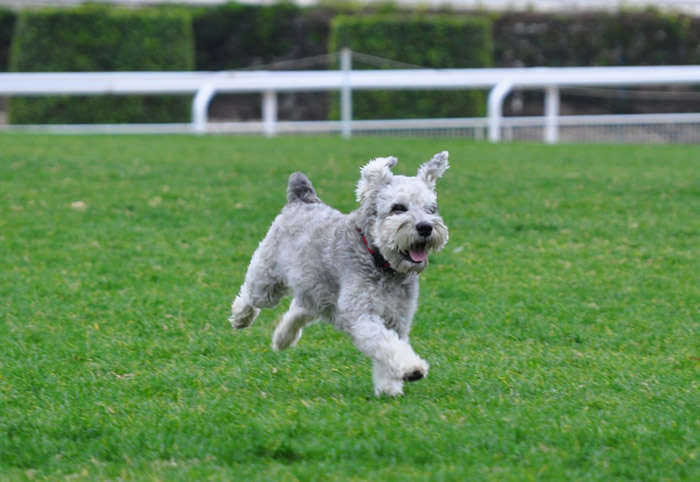Games with dog
Dogs that receive daily exercise are happier and show better social behavior. It is an effective way to prevent your dog from engaging in destructive behavior. Exercise and games with dog also offer physical benefits: develop muscles, strengthen cardiovascular system, prevent obesity, strengthen bones, improve sleep, enhances mental alertness and promote health. But just letting your dog to backyard does not give the exercise a dog needs. You need to engage in exercise and games with dog that can provide mental stimulation and an outlet for its physical energy. There are many dog games and exercises for keeping your dog fit, such as ball fetching, jogging, agility training, Frisbee, tracking, lure coursing and obedience competition.

The important question is how much exercise your dog needs. Some dogs need two-mile runs every day while others need 30-minute walks. Some dogs enjoy complex puzzles and games for dogs while others are harder to engage. The important question is knowing how much exercise and mental stimulation your dog needs. The amount of exercise a dog needs depends on his age, size and breed.
Age
Puppies enjoy puzzles and games with dog to simulate their minds and satisfy their curiosity. Play a variety of games with your puppy to keep him entertained. A simple game your dog will enjoy is “Find the Treat”, where you hide treats for your dog to find. You can alter the difficulty of the game by hiding the treats in hard to access areas such as under a metal bowl. As for physical exercise, puppies should receive daily exercise to aid muscle development but prolonged jogging is too hard on their joints and not recommended.
Adolescent dogs have lots of energy to exert. It is very likely that they have more energy than their owners. So jogging with an adolescent dog may not be the most effective way of exercising him. Instead, use a variety of high-intensity games to provide maximum exercise for an adolescent dog at minimum effort for the owner.
As for older dogs, they have less need for rigorous exercise and may even need your encouragement to start jogging. Play a lot of games for dogs to keep them mentally active and healthy.
Size
In general small dogs need less exercise than big dogs. But there are many exceptions so dog breed is a better indication of how much exercise a dog needs. Couple things you should remember about dog size and exercise need are:
|
Breed
Each dog breed has different exercise needs because they are bred for different purposes. Herding dogs, like Australian Cattle Dog, Border Collie or English Sheepdog were bred for herding. As such, they require long runs and agility training. Hounds on the other hand are bred for short distance sprinting so they need exercise and games that help them release short bursts of intense energy. Some breeds are bred for their looks and have features that prevent them from doing certain exercises. For example, short-nosed breeds, like Pug, Bulldog and Boxer, have trouble breathing when exercised vigorously. So before you start exercising with your dog, understand what its breed was originally bred to do to find out how much exercise he needs.
Foreword about exercise and games with dog
Before you start any heavy exercise with your dog, have your veterinarian assess your dog’s fit ness level. The veterinarian should check your dog’s cardiovascular system as well as his joints and ligaments to ensure they are healthy.
ness level. The veterinarian should check your dog’s cardiovascular system as well as his joints and ligaments to ensure they are healthy.
Make sure your dog has gone through obedience training and knows how to heel (work beside you), sit, and stay. This will be important when you start jogging to prevent your dog from dragging your forward or suddenly stopping. Constantly pulling on the leash and sudden stops can damage your dog’s throat. Knowing to obey sit and stay is also critical when doing exercise and games with dog to command your dog to stop at intersections and at approach of other dogs or cyclists.
Be mindful of the weather condition. Avoid exercising under the heat of the day when it is easy to get heatstroke and when hot pavement can hurt your dog’s paws. The same care should be taken in cold winters where pavement can be slippery. Remember unfriendly weather is no excuse for not exercising your dog. Don’t let a few drops of rain prevent you from going out with your dog. Save the indoor exercise days for extreme weather like hurricane and tornado.
When doing exercise and games with dog, be observant for signs of overexertion. You dog will not be able to tell you he is tired. In fact, it is his nature to try to keep up with his master no matter what. As a caring owner, you should watch out for signs of fatigue. Frequent stopping and heavy panting are signals for a break or water. If the dog is reluctant to continue after a break, it may be time to go home.
Fun and Games with dog
There are many games you can play with your dog to exercise his mind and body. Teach your dog a variety to keep it interesting for both you and the dog. Start with several simple games with dog and work your way to teach him more complicated ones.
Fetch: Probably the first one that comes to mind when thinking about games with dog. Fetch is a simple command and you can use the “bait and switch” routine to teach your dog.
| How to teach your dog fetch |
|---|
|
Agility Training: Dogs’ ancestors were required to chase down prey while avoiding obstacles. You can let your dog exert this instinct by building an obstacle course. This is a high intensity exercise that improves your dog’s coordination, endurance, agility and problem-solving capabilities. If you are not planning to have your dog compete in agility courses, you don’t need to be concerned about getting special equipment for making the obstacles. Use a combination of old tires, wood planks, tubes, plastic sheets, hula hoops and ropes to create tunnels, seesaws, pause boxes, jumps, weave poles and A-frames.
Frisbee: Provides an intense workout for your dog with little effort from you. It is a great game for dog breeds that have lots of energy and loves sprinting after preys. You need to have taught your dog how to fetch and buy Frisbees made especially for dogs to reduce risk of injuring your dog.
Swimming: a good aerobic exercise for your dog if he can be taught. Dogs that can be taught to swim include Water Spaniels, Retrievers, Akitas, Poodles and Settlers. Other dogs are not meant for swimming like Pugs, Bulldogs, Greyhounds, Boston Terriers and Dachshunds. Once you have taught your dog how to swim, you can also play fetch and other games with him in the water. Just always remember to use a lifejacket and never leave a dog unattended in the water.
Safety while exercising and playing games with dog
- Look out for dangers such as broken pavement, icy patches, broken glasses, rodent poison and food rubbish.
- Always use a leash for the safety of your dog and others. Your dog may get excited and chase after prey animals.
- Carry a stick to protect yourself and your dog if approached by unleashed dogs or wild animals.
- Use reflective bands on yourself and your dog if exercising at night.
- Avoid heavy exercise right after eating.
- Keep your dog hydrated with fresh water and know what to do in case of heatstroke.
